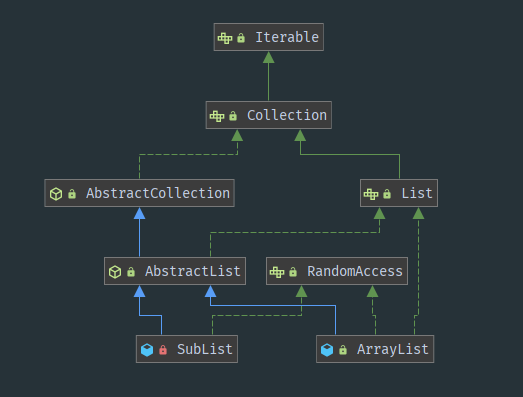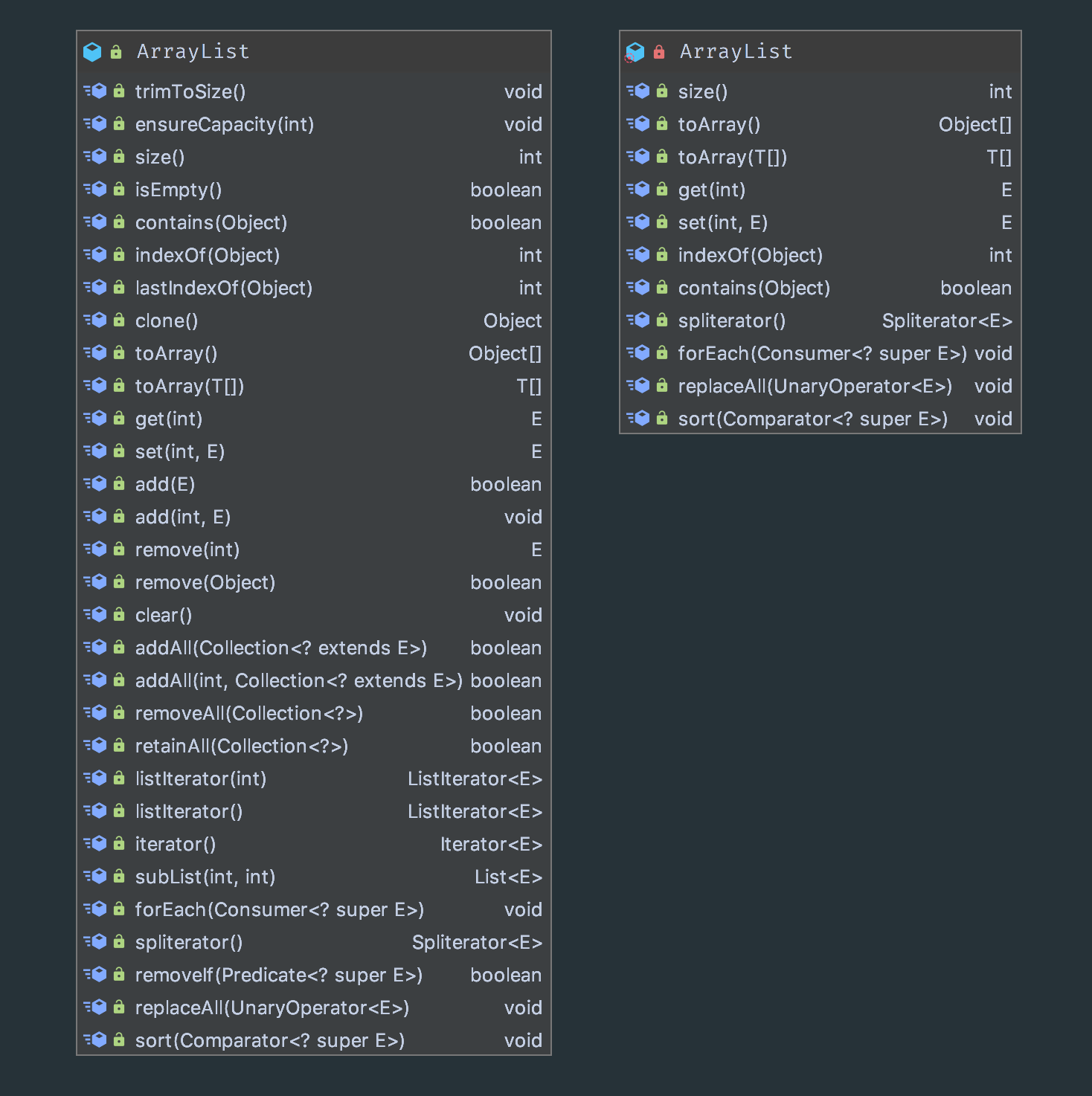**
《手册》 第 11-12 页 对
ArrayList
的
subList
和
Arrays.asList()
进行了如下描述 1:
【强制】ArrayList 的 subList 结果不可强转成 ArrayList,否则会抛出 ClassCastException 异 常,即 java.util.RandomAccessSubList cannot be cast to java.util.ArrayList。
【强制】在 SubList 场景中,高度注意对原集合元素的增加或删除,均会导致子列表的遍历、增加、删除产生 ConcurrentModificationException 异常。
【强制】使用工具类 Arrays.asList () 把数组转换成集合时,不能使用其修改集合相关的方法,它的 add/remove/clear 方法会抛出 UnsupportedOperationException 异常。
那么我们思考下面几个问题:
- 《手册》为什么要这么规定?
- 这对我们编码又有什么启发呢?
**
通过前面章节的学习,相信很多人已经对通过使用类图、阅读源码和源码的注释等来学习方法已经轻车熟路了。
下面我们根据本节话题继续实战。
**
**
通过 IDEA 的提供的类图工具,我们可以查看该类的继承体系。
具体步骤:在
SubList
类中 右键,选择 “Diagrams” -> “Show Diagram” 。 可以看到
可以看到
SubList
和
ArrayList
的继承体系非常类似,都实现了
RandomAccess
接口 继承自
AbstarctList。
SubList
和
ArrayList
并没有继承关系,因此 “
ArrayList
的
SubList
并不能强转为
ArrayList
。
通过类图我们对
SubList
**
如果想学习某个特性,最好的方法之一就是写一个小段 DEMO 来观察分析。
因此我们下面,写一个简单的测试代码片段来验证转换异常问题:
@Test(expected = ClassCastException.class)public void testClassCast() {List<Integer> integerList = new ArrayList<>();integerList.add(0);integerList.add(1);integerList.add(2);List<Integer> subList = integerList.subList(0, 1);// 强转ArrayList<Integer> cast = (ArrayList<Integer>) subList;}
我们还可以使用调试的表达式功能来验证我们的想法。
在调试界面的 “Variables” 窗口选择想研究的对象,如
subList
,然后右键选择 “Evaluate Expression”,输入想查执行的表达式,查看结果:
从上面的表达式的结果也可以清晰地看出,
subList
并不是
ArrayList
类型的实例。
我们写一个代码片段来验证功能:
@Testpublic void testSubList() {List<String> stringList = new ArrayList<>();stringList.add("赵");stringList.add("钱");stringList.add("孙");stringList.add("李");stringList.add("周");stringList.add("吴");stringList.add("郑");stringList.add("王");List<String> subList = stringList.subList(2, 4);System.out.println("子列表:" + subList.toString());System.out.println("子列表长度:" + subList.size());subList.set(1, "慕容");System.out.println("子列表:" + subList.toString());System.out.println("原始列表:" + stringList.toString());}
输出结果为:
子列表:[孙,李]
子列表长度:2
子列表:[孙,慕容]
原始列表:[赵,钱,孙,慕容,周,吴,郑,王]
可以观察到,对子列表的修改最终对原始列表产生了影响。
那么为啥修改子序列的索引为 1 的值影响的是原始列表的第 4 个元素呢?后面将进行分析和解读。
**
java.util.ArrayList#subList
源码:
/*** Returns a view of the portion of this list between the specified* {@code fromIndex}, inclusive, and {@code toIndex}, exclusive. (If* {@code fromIndex} and {@code toIndex} are equal, the returned list is* empty.) The returned list is backed by this list, so non-structural* changes in the returned list are reflected in this list, and vice-versa.* The returned list supports all of the optional list operations.** <p>This method eliminates the need for explicit range operations (of* the sort that commonly exist for arrays). Any operation that expects* a list can be used as a range operation by passing a subList view* instead of a whole list. For example, the following idiom* removes a range of elements from a list:* <pre>* list.subList(from, to).clear();* </pre>* Similar idioms may be constructed for {@link #indexOf(Object)} and* {@link #lastIndexOf(Object)}, and all of the algorithms in the* {@link Collections} class can be applied to a subList.** <p>The semantics of the list returned by this method become undefined if* the backing list (i.e., this list) is <i>structurally modified</i> in* any way other than via the returned list. (Structural modifications are* those that change the size of this list, or otherwise perturb it in such* a fashion that iterations in progress may yield incorrect results.)** @throws IndexOutOfBoundsException {@inheritDoc}* @throws IllegalArgumentException {@inheritDoc}*/public List<E> subList(int fromIndex, int toIndex) {subListRangeCheck(fromIndex, toIndex, size);return new SubList(this, 0, fromIndex, toIndex);}
通过源码可以看到该方法主要有两个核心逻辑:一个是检查索引的范围,一个是构造子列表对象。
通注释我们可以学到核心知识点:
该方法返回本列表中 fromIndex (包含)和 toIndex (不包含)之间的元素视图。如果两个索引相等会返回一个空列表。
如果需要对 list 的某个范围的元素进行操作,可以用 subList,如:
list.subList(from, to).clear();
任何对子列表的操作最终都会反映到原列表中。
我们查看函数
java.util.ArrayList.SubList#set
源码:
public E set(int index, E e) {rangeCheck(index);checkForComodification();E oldValue = ArrayList.this.elementData(offset + index);ArrayList.this.elementData[offset + index] = e;return oldValue;}
可以看到替换值的时候,获取索引是通过
offset + index
计算得来的。
这里的
java.util.ArrayList#elementData
即为原始列表存储元素的数组。
SubList(AbstractList<E> parent,int offset, int fromIndex, int toIndex) {this.parent = parent;this.parentOffset = fromIndex;this.offset = offset + fromIndex;this.size = toIndex - fromIndex;this.modCount = ArrayList.this.modCount; // 注意:此处复制了 ArrayList的 modCount}
通过子列表的构造函数我们知道,这里的偏移量 (
offset
) 的值为
fromIndex
参数。
因此上小节提到的: 为啥子序列的索引为 1 的值影响的是原始列表的第 4 个元素呢? 的问题就不言自明了。
另外在
SubList
的构造函数中,会将
ArrayList
的
modCount
赋值给
SubList
的
modCount
。
我们再回到规约中规定:
【强制】在 subList 场景中,高度注意对原集合元素的增加或删除,均会导致子列表的遍历、增加、删除产生 ConcurrentModificationException 异常。
我们看
java.util.ArrayList#add(E)
的源码:
/*** Appends the specified element to the end of this list.** @param e element to be appended to this list* @return <tt>true</tt> (as specified by {@link Collection#add})*/public boolean add(E e) {ensureCapacityInternal(size + 1); // Increments modCount!!elementData[size++] = e;return true;}
可以发现新增元素和删除元素,都会对
modCount
进行修改。
我们再看
SubList
的 核心的函数,如
java.util.ArrayList.SubList#get
和
java.util.ArrayList.SubList#size
:
public E get(int index) {rangeCheck(index);checkForComodification();return ArrayList.this.elementData(offset + index);}public int size() {checkForComodification();return this.size;}
都会进行修改检查:
java.util.ArrayList.SubList#checkForComodification
private void checkForComodification() {if (ArrayList.this.modCount != this.modCount)throw new ConcurrentModificationException();}
而从上面的
SubList
的构造函数我们可以看到,
SubList
复制了 ArrayList 的 modCount,因此对原函数的新增或删除都会导致
ArrayList
的
modCount
的变化。而子列表的遍历、增加、删除时又会检查创建
SubList
时的 modCount 是否一致,显然此时两者会不一致,导致抛出
ConcurrentModificationException
**
**
和前面一样,查看类图来了解
Arrays.asList()
的返回类型。
发现该
java.util.Arrays.ArrayList
(右侧) 和
java.util.ArrayList
(左侧),的继承体系非常相似,继承自
java.util.AbstractList
。
我们打开左上角的 “Method” 功能,对比两者的主要函数的异同:
我们可以清楚地发现,
java.util.Arrays.ArrayList
(右侧) 并没有像左侧一样 重写
add
、
remove
**
接下来我们分析
Arrays.asList()
的源码:
/*** Returns a fixed-size list backed by the specified array. (Changes to* the returned list "write through" to the array.) This method acts* as bridge between array-based and collection-based APIs, in* combination with {@link Collection#toArray}. The returned list is* serializable and implements {@link RandomAccess}.** <p>This method also provides a convenient way to create a fixed-size* list initialized to contain several elements:* <pre>* List<String> stooges = Arrays.asList("Larry", "Moe", "Curly");* </pre>** @param <T> the class of the objects in the array* @param a the array by which the list will be backed* @return a list view of the specified array*/@SafeVarargs@SuppressWarnings("varargs")public static <T> List<T> asList(T... a) {return new ArrayList<>(a);}
通过注释我们可以得到下面的要点:
返回基于特定数组的定长列表。
该方法扮演数组到集合的桥梁。
该方法也提供了包含多个元素的定长列表的方法:
List stooges = Arrays.asList(“Larry”, “Moe”, “Curly”);
可看出此方法的功能是为了返回定长的列表。
这里的” 定长列表 “的描述非常重要,这也就解释了为什么不支持增加和删除元素的原因。
结合前面的类图,我们去查看
AbstactList
的
add
和
remove
相关函数:
java.util.AbstractList#add(int, E)
public void add(int index, E element) {throw new UnsupportedOperationException();}
java.util.AbstractList#remove
public E remove(int index) {throw new UnsupportedOperationException();}
可知如果子类不重写这两个函数,就会抛出
UnsupportedOperationException
(不支持的操作异常)。
我们再看看
java.util.AbstractList#clear
的源码:
/*** Removes all of the elements from this list (optional operation).* The list will be empty after this call returns.** <p>This implementation calls {@code removeRange(0, size())}.** <p>Note that this implementation throws an* {@code UnsupportedOperationException} unless {@code remove(int* index)} or {@code removeRange(int fromIndex, int toIndex)} is* overridden.** @throws UnsupportedOperationException if the {@code clear} operation* is not supported by this list*/public void clear() {removeRange(0, size());}
通过注释可知 如果没有重写
remove(int index)
或
removeRange(int fromIndex, int toIndex)
同样也会抛出
UnsupportedOperationException
**
在 Java 的学习过程中,大多数人都是通过看视频,读博客,搜索引擎搜索,买书等来学习知识。
但是很多资料都是告诉你结论,但这样容易浮于表面,知其然而不知其所以然。而源码、官方文档等才是权威的知识。
希望从现在开始学习和开发中能够偶尔到感兴趣的类中查看源码,这样学的更快,更扎实。通过进入源码中自主研究,这样印象更加深刻,掌握的程度更深。
我们同样发现学习的手段并非只有一种,往往多种研究方式结合起来效果最好。
**
本文通过类图分析、源码分析以及 DEMO 和调试的方式对
ArrayList
的
SubList
问题和
Arrays
的asList
进行分析。并根据分析阐述了对我们学习的启发。
本节的要点:ArrayList
内部类SubList
和
ArrayList
没有继承关系,因此无法将其强转为ArrayList
。ArrayList
的SubList
构造时传入ArrayList
的modCount
,因此对原列表的修改将会导致子列表的遍历、增加、删除产生 ConcurrentModificationException 异常。
Arrays.asList()
函数是提供通过数组构造定长集合的功能,该函数提供数组到集合的桥梁。
下一节我们将讲述添加注释的正确姿势。
**
《手册》第 11 页 集合处理章节有这么一条规定:
【强制】不要在 foreach 循环里进行元素的 remove/add 操作。remove 元素请使用 Iterator 方式,如果并发操作,需要对 Iterator 对象加锁。
那么问题来了,为什么 “不要在 foreach 循环里进行元素的 remove/add 操作。remove 元素请使用 Iterator 方式”?
请大家结合前面和本小节所学的内容自己实际动手研究一下。
**
- 阿里巴巴与 Java 社区开发者.《 Java 开发手册 1.5.0》华山版. 2019. 11-12 ↩︎
精选留言 1
欢迎在这里发表留言,作者筛选后可公开显示
其实和文章前面分析的是一个情况,使用foreach遍历,编译器会编译为使用Iterator的方式进行遍历,会以hashNext()方法为循环条件,通过next()函数获取下一个值,而next()函数中第一步就是chekForComodification(),也就是并发修改检查,结果不言而喻 而通过Iterator的方式进行修改,在每次remove操作后,都会将expectedModCount重新赋值,自然不会在next()中引发异常
1
回复
2019-12-09
回复letro
很多知识都是会者不难,难者不会,希望大家看专栏更多地是看分析问题的过程和方法,而不是追求某个具体知识会。 就像我说的看答案做题,看啥都头头是道,觉得啥都简单,这不是一个好现象,能够快速解决新问题才代表真正掌握。 能够解释某个见到过的具体问题并不是最终目的,这只是讲方法的一个素材。
回复
2019-12-11 10:13:38
回复letro
希望大家更注重遇到类似问题时,应该从源码,从反汇编等角度去学习,这才是最核心的,某个具体问题是生疏还是能够信手拈来只是一个具体应用。 不过能够思路清晰地表达出来说明理解的挺不错。

